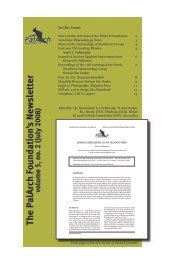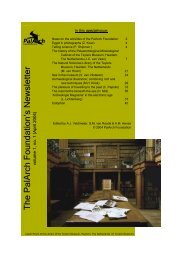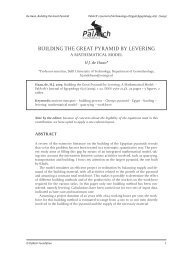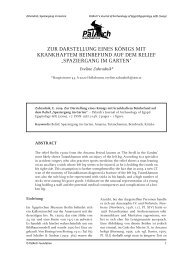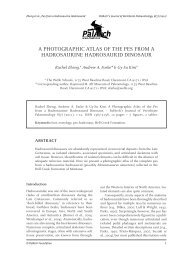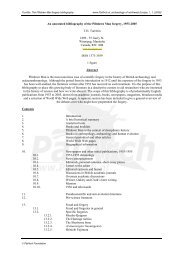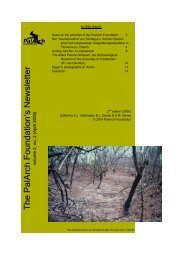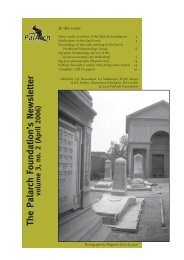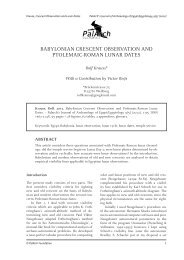neural spine bifurcation in sauropod dinosaurs of the - PalArch
neural spine bifurcation in sauropod dinosaurs of the - PalArch
neural spine bifurcation in sauropod dinosaurs of the - PalArch
You also want an ePaper? Increase the reach of your titles
YUMPU automatically turns print PDFs into web optimized ePapers that Google loves.
Wedel & Taylor, Neural Sp<strong>in</strong>e Bifurcation <strong>in</strong> Sauropods <strong>PalArch</strong>’s Journal <strong>of</strong> Vertebrate Palaeontology, 10(1) (2013)<br />
Figure 3. A middle cervical vertebra <strong>of</strong> a human <strong>in</strong> cranial<br />
view show<strong>in</strong>g paired bony processes for <strong>the</strong> attachment<br />
<strong>of</strong> dorsal muscles to <strong>the</strong> <strong>neural</strong> <strong>sp<strong>in</strong>e</strong>. Uncatalogued<br />
specimen from <strong>the</strong> anthropology teach<strong>in</strong>g collection at <strong>the</strong><br />
University <strong>of</strong> California, Santa Cruz.<br />
stood. It is possible that <strong>in</strong> some vertebrae <strong>the</strong><br />
paired embryonic <strong>neural</strong> arch elements never<br />
fused except to form a ro<strong>of</strong> over <strong>the</strong> <strong>neural</strong> canal.<br />
In contrast, <strong>in</strong> <strong>the</strong> genus Camarasaurus it<br />
is possible that many <strong>of</strong> <strong>the</strong> presacral <strong>neural</strong><br />
<strong>sp<strong>in</strong>e</strong>s were not bifid <strong>in</strong> young animals, and<br />
that <strong>the</strong> degree <strong>of</strong> <strong>bifurcation</strong> <strong>in</strong>creased over<br />
<strong>the</strong> course <strong>of</strong> ontogeny (see below).<br />
In a recently-published paper, Woodruff &<br />
Fowler (2012) argued that <strong>the</strong> degree <strong>of</strong> <strong>bifurcation</strong><br />
<strong>of</strong> <strong>sauropod</strong> <strong>neural</strong> <strong>sp<strong>in</strong>e</strong>s was ontogenetically<br />
controlled, with <strong>the</strong> simple, undivided<br />
<strong>sp<strong>in</strong>e</strong>s <strong>of</strong> juveniles gradually separat<strong>in</strong>g <strong>in</strong>to<br />
paired metapophyses over <strong>the</strong> course <strong>of</strong> posthatch<strong>in</strong>g<br />
ontogeny. Based on this <strong>in</strong>ferred ontogenetic<br />
trajectory, Woodruff & Fowler (2012)<br />
fur<strong>the</strong>r argued that currently recognized <strong>sauropod</strong><br />
taxa are oversplit, and that when ontogenetic<br />
transformations were taken <strong>in</strong>to account,<br />
it would be necessary to synonymize several<br />
taxa. In particular, <strong>the</strong>y argued that <strong>the</strong> Morrison<br />
Formation diplodocoid Suuwassea was a<br />
juvenile <strong>of</strong> a known diplodocid (Ibidem: 6-8),<br />
that Haplocanthosaurus and Barosaurus were<br />
likewise suspect (Ibidem: 9), and that rebbachisaurids<br />
were possibly paedomorphic dicraeosaurids<br />
(Ibidem: 8-9).<br />
Our goals <strong>in</strong> this paper are, first, to re-exam<strong>in</strong>e<br />
<strong>the</strong> evidence for an ontogenetic <strong>in</strong>crease <strong>in</strong><br />
<strong>neural</strong> <strong>sp<strong>in</strong>e</strong> <strong>bifurcation</strong> <strong>in</strong> <strong>sauropod</strong>s, and <strong>the</strong>n<br />
to evaluate <strong>the</strong> synonymies proposed by Woodruff<br />
& Fowler (2012). Although bifid <strong>neural</strong><br />
<strong>sp<strong>in</strong>e</strong>s also occur <strong>in</strong> o<strong>the</strong>r <strong>sauropod</strong>s, as noted<br />
above, <strong>the</strong> hypo<strong>the</strong>ses <strong>of</strong> Woodruff & Fowler<br />
(2012) depend on ontogenetic <strong>in</strong>ferences drawn<br />
from Morrison Formation <strong>sauropod</strong> taxa, and<br />
<strong>the</strong>refore we are conf<strong>in</strong><strong>in</strong>g our discussion to<br />
those taxa (e.g. Camarasaurus, Haplocanthosaurus,<br />
and <strong>the</strong> Morrison diplodocoids).<br />
Abbreviations<br />
AMNH, American Museum <strong>of</strong> Natural History,<br />
New York City, New York, USA;<br />
BYU, Earth Sciences Museum, Brigham Young<br />
University, Provo, Utah, USA;<br />
CM, Carnegie Museum <strong>of</strong> Natural History, Pittsburgh,<br />
Pennsylvania, USA;<br />
FMNH, Field Museum <strong>of</strong> Natural History, Chicago,<br />
Ill<strong>in</strong>ois, USA;<br />
MB.R., Museum für Naturkunde Berl<strong>in</strong>, Germany;<br />
NSMT, National Science Museum, Tokyo, Japan;<br />
OMNH, Oklahoma Museum <strong>of</strong> Natural History,<br />
Norman, Oklahoma, USA;<br />
SMNS, Staatliches Museum für Naturkunde,<br />
Stuttgart, Germany;<br />
USNM, National Museum <strong>of</strong> Natural History,<br />
Wash<strong>in</strong>gton, D.C., USA;<br />
UWGM, University <strong>of</strong> Wyom<strong>in</strong>g Geological<br />
Museum, Laramie, Wyom<strong>in</strong>g, USA;<br />
WPL, Western Paleontological Laboratories,<br />
Lehi, Utah, USA;<br />
YPM, Yale Peabody Museum, New Haven, Connecticut,<br />
USA.<br />
Materials and Methods<br />
Neural <strong>sp<strong>in</strong>e</strong> <strong>bifurcation</strong> <strong>in</strong> <strong>sauropod</strong>s is a cont<strong>in</strong>uum<br />
from completely unsplit <strong>sp<strong>in</strong>e</strong>s to those<br />
that are completely separated down to <strong>the</strong> ro<strong>of</strong><br />
<strong>of</strong> <strong>the</strong> <strong>neural</strong> canal. For <strong>the</strong> sake <strong>of</strong> convenience,<br />
<strong>in</strong> this paper we classify <strong>neural</strong> <strong>sp<strong>in</strong>e</strong>s <strong>in</strong>to four<br />
categories based on <strong>the</strong>ir degree <strong>of</strong> <strong>bifurcation</strong>:<br />
1) Sp<strong>in</strong>es that entirely lack any midl<strong>in</strong>e <strong>in</strong>dentation<br />
are described as unsplit;<br />
2) Those with extremely shallow notches <strong>in</strong> <strong>the</strong><br />
dorsal marg<strong>in</strong>, whose depth is less than <strong>the</strong><br />
m<strong>in</strong>imum width <strong>of</strong> <strong>the</strong> <strong>sp<strong>in</strong>e</strong> itself, are described<br />
as notched;<br />
3) Those that are split over less than half <strong>the</strong><br />
distance from <strong>the</strong> <strong>sp<strong>in</strong>e</strong> tips to ei<strong>the</strong>r <strong>the</strong><br />
postzygapophyses or transverse processes<br />
(whichever are higher) are described as shallowly<br />
bifid;<br />
4) Those split over more than half that distance<br />
are described as deeply bifid (figure 4).<br />
© <strong>PalArch</strong> Foundation 4



